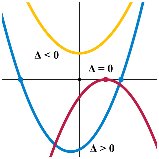|
|
|
|
|
|||||||||||
|
|
|||||||||||||||

UNIT
2 : FUNCTIONS
LESSON
9: UNIT TEST SOLUTIONS
1. Determine whether or not each of the
following is a function.
a) {(-5, 7), (-3, 4), (-1, 1), (-1, -2), (-3,
-5), (-5, -8)}
Solution:
Not a function – several ordered pairs have the same first element – eg
– (-5, 7) and (-5, 8)
b) f(x) = (x – 3)2 + 1
Solution:
Yes, this is a function – the graph is a parabola opening up with vertex
at (3, 1). A vertical line would cut it
only once.
Also, if
you substitute a value in the equation for x (input value), you get only one
answer for y (output value). Hence, it
is a function.
c) d)


Solution: Using the vertical line test, c)
is a function and d) is not.
2. In each of above, state the domain and
range.
Solution: a) Domain = {-5, -3, -1} Range
= {7, 4, 1, -2, -5, -8}
b)
Domain = ![]() Range
=
Range
= ![]()
c) Domain = ![]() Range
=
Range
= ![]()
d) Domain = ![]() or
or ![]() Range =
Range = ![]()
![]()
3. Determine the equation of the inverse of
each function. Is the inverse a
function? If the inverse is not a
function, restrict the domain so that it is a function. Explain all steps fully.
a) f(x) = 3x – 5
b) g(x) = x2 – 1
Solution:
a)
Rewrite as y = 3x – 5
x = 3y – 5 ** interchange x and y
3y = x + 5
![]() ** divide both sides by 3
** divide both sides by 3
y = 1/3 x + 5/3 ** isolate y
Hence f –1 (x) = 1/3 x + 5/3 ** rewrite in function notation
b)
Rewrite as y = x2 – 1
x = y2 – 1 ** interchange x and y
y2 = x + 1 ** isolate “y2 “

4. If f(x) = 5 – 3x2, determine each
of the following.
a) f(2) b) f(-3) c) f(2m) d) f(2a – 1) – f(a – 1)
Solution:
a) f(2) = 5 – 3(2)2 = 5 – 3(4) = -7 b) f(-3) = 5 – 3(-3)2
= 5 – 3(9) = -22 c) f(2m) = 5 – 3(2m)2 =
5 – 3(4m2) = 5 – 12m2
d) f(2a – 1) – f(a – 1) = [5 – 3(2a – 1)2] – [5 – 3(a –
1)2]
= [5 – 3(4a2
– 4a + 1)] – [5 – 3(a2 –2a + 1)]
= 5 – 12a2
+12a – 3 – [5 – 3a2 + 6a – 3]
= 2 – 12a2
+ 12a + 3a2 –6a – 2
= -9a2
+ 6a
5. Given
a function y = f(x), describe in words how each of the following functions can
be obtained from y = f(x).
a) f(x – 1) + 4 b) ½ f(-3x) + 5 c)
–f(-2x – 6) + 1
a) f(x – 1) + 4
·
Horizontal
translation (shift) right 1 unit
·
Vertical
translation (shift) up 4 units
b) ½ f(-3x) + 5
·
Vertical
compression factor ½
·
Reflection
in the y-axis
·
Horizontal
compression factor 1/3
·
Vertical
translation up 5 units
c)
–f(-2x – 6) + 1 = - f[-2(x + 3)] + 1
·
Reflection
in the x-axis
·
Reflection
in the y-axis
·
Horizontal
translation left 3 units
·
Vertical
translation up 1 unit
6. In each case the red graph is a
transformation of the blue graph.
Determine the equation of the red
graph (the equation of
the blue graph is given).
a)
Equation of blue graph is y = g(x) b) Equation of blue graph is
![]()
Solution:


a)
Note that the height of the red graph is 9 units (-8 to +1) and the
height of the blue graph is 9 (-5 to +4).
Hence no vertical stretch or
compression.
Also the
width of the blue graph is 6 (-4 to +2) while the width of the red graph is
3. This implies a horizontal compression factor 2.
There is
also a reflection in the y – axis because the orientation is
reversed in that direction.
To
obtain the translation, we follow the
point (-4, -2) using the
above transformations and then determine
the translation still needed to
get to its
image (3, -5).
(-4, -2)
---------------à (4, -2) **
reflection in the y-axis
(4, -2)
----------------à (2, -2) **
horizontal compression factor 2
Now (2,
-2) needs a translation right 1 and down 3 to get to its image (3, -5).
This
combination of transformations results in the equation: g[-2(x
– 1)] – 3.
In
mapping form: (x, y) ---------------------à (-½ x + 1, y – 3)
b) The required transformations are
·
Vertical
stretch factor 2
·
Horizontal
translation left 3 units
·
Vertical
translation up 1 unit
![]()
7. The
following transformations are applied to the graph of ![]() .
.
·
Reflection
in the x-axis
·
Horizontal
compression factor ½
·
Horizontal
translation right 3 units
a) Write the combined result of the
transformations in mapping form.
b) Write the equation of the transformed
function.
c) Sketch the graph of both functions
Solution:

d) State the domain and range of the
transformed function.
a) (x, y) ----------------------à (½ x + 3, -y)
![]()
c) See graph above
d)
![]()
![]()
![]()
![]()
8. (a)
For the graph of y = g(x) below, list the transformations that must be applied
to obtain
y = -2g(2x – 6) + 1
(b) Draw
the graph of y = -2g(2x – 6) + 1.

 Solution: Rewrite the equation as y = -2g[2(x
– 3)] + 1
Solution: Rewrite the equation as y = -2g[2(x
– 3)] + 1
The
required transformations are;
·
Reflection
in the x-axis
·
Vertical
stretch factor 2
·
Horizontal
compression factor ½
·
Horizontal
translation right 3 units
·
Vertical
translation up 1 unit
Mapping
form: (x, y) --------------------à (½ x + 3, -2y + 1)
Using
points on the give (blue) graph, we obtain the transformed graph.
(x, y) --------------------à (½ x + 3, -2y + 1)
(-4, -3)
----------------à (1, 7)
(-2, -3)
----------------à (2, 7)
(0, 2)
------------------à (3, -3)
(3, -1)
-----------------à (4.5, 3)
See red graph at left.



